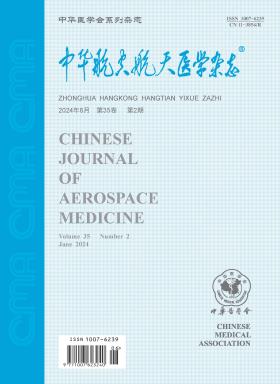Experimental study of a membrane compliance cavity to improve vitro simulation of the human circulation system under acceleration environment
引用次数: 0
Abstract
Objective To improve the vitro simulation of the human circulation system under acceleration environment by studying a membrane compliance cavity. Methods The vitro simulation of the human circulation system equipped with a membrane cavity wherein the air and liquid was separated by a silicone membrane (0.2 mm or 0.4 mm thick) in order to prevent the gas got into the system as soon as the simulated acceleration caused air-liquid interface tilt. The segmentation of air-liquid interface and deformation of silicone membranes were recorded by a high definition camera when 20 to 200 mmHg pressure applied to the cavity to simulate the acceleration effect. The compliance values at different pressures were calculated. Results ①No air was found in the closed liquid loop when cavity was pressured. The deformation of 0.2 mm membrane was larger than that of 0.4 mm membrane. ②The membrane compliance cavity showed viscoelasticity feature both in pressure loading and unloading processes. When the cyclic loading was up to 3 times the loading curve of 0.2 mm membrane compliance cavity was almost overlapped on its unloading curve, but they did not coincide for the 0.4 mm membrane. ③The simulation range of 0.2 mm silicone membrane was in 0-1.4 ml/mmHg under 20-200 mmHg test pressures, while 0-0.4 ml/mmHg for 0.4 mm silicone membrane. Conclusions The membrane compliance cavity has solved the problem of the air-liquid interface segmentation under the simulated acceleration environment. The simulation range of compliance meets the needs of the vitro simulation for human circulatory system. Key words: Acceleration physiology; Blood circulatory; Compliance; In vitro simulation; Silica membrane cavity; Pilots膜顺应腔提高体外模拟加速环境下人体循环系统的实验研究
目的通过膜顺应腔的研究,改进体外加速环境下人体循环系统的模拟。方法体外模拟人体循环系统,设置膜腔,其中空气和液体由0.2 mm或0.4 mm厚的硅胶膜分离,以防止气体在模拟加速度引起气液界面倾斜时立即进入系统。用高清摄像机记录了在20 ~ 200 mmHg的压力作用下,气液界面的分割和硅膜的变形,模拟了加速效应。计算了不同压力下的柔度值。结果①对腔体加压时,封闭液回路内无空气。0.2 mm膜的变形大于0.4 mm膜的变形。②膜柔腔在压力加载和卸载过程中均表现出粘弹性特征。当循环加载达到3倍时,0.2 mm膜的加载曲线与卸载曲线几乎重合,而0.4 mm膜的加载曲线与卸载曲线不重合。③在20 ~ 200 mmHg测试压力下,0.2 mm硅胶膜的模拟范围为0 ~ 1.4 ml/mmHg, 0.4 mm硅胶膜的模拟范围为0 ~ 0.4 ml/mmHg。结论膜顺应腔解决了模拟加速度环境下气液界面分割问题。顺应性模拟范围满足人体循环系统体外模拟的需要。关键词:加速度生理学;血液循环;合规;体外模拟;硅膜腔;飞行员
本文章由计算机程序翻译,如有差异,请以英文原文为准。
求助全文
约1分钟内获得全文
求助全文
来源期刊

中华航空航天医学杂志
航空航天医学
自引率
0.00%
发文量
2962
期刊介绍:
The aim of Chinese Journal of Aerospace Medicine is to combine theory and practice, improve and popularize, actively advocate a hundred flowers bloom and a hundred schools of thought contend, advocate seeking truth from facts, promote the development of the related disciplines of aerospace medicine and human efficiency, and promote the exchange and penetration of aerospace medicine and human efficiency with other biomedical and engineering specialties.
Topics of interest for Chinese Journal of Aerospace Medicine include:
-The content of the journal belongs to the discipline of special medicine and military medicine, with the characteristics of multidisciplinary synthesis and cross-penetration, and mainly reflected in the aerospace industry, aerospace flight safety and efficiency, as well as the synthesis of special medicine, preventive medicine, environmental medicine, psychology, etc.
-Military aeromedicine (Air Force, Navy and Army aeromedicine) and civil aeromedicine, with a balance of aerospace medicine are the strengths of the journal.
-The change in aerospace medicine from a focus on promoting physiological compensatory adaptations to enhancing human performance under extreme environmental conditions is what the journal is helping to promote.
-The expansion of manuscripts in high altitude medicine is also a special emphasis of the journal.
 求助内容:
求助内容: 应助结果提醒方式:
应助结果提醒方式:


